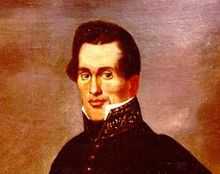Lawrence Taliaferro

Lawrence Taliaferro (/ˈtʌlɪvər/; February 28, 1794–January 22, 1871)[1] was a United States Army officer best known for his service as an Indian agent at Fort Snelling, Minnesota from 1820 through 1839 and also as an individual who played a part in the saga of the famous African American slave Dred Scott.
Biography
Taliaferro was born at Whitehall Plantation in King George County, Virginia to James Garnett Taliaferro and his wife Wilhelmina (Wishart) Taliaferro. During the War of 1812, he enlisted at age 18 as a volunteer in a Virginia militia company. He was soon picked to study for a regular Army commission, and was made an ensign in the 1st United States Infantry Regiment. He chose to remain in the Army after the war, intending to make it his career.
Taliaferro partnered with Colonel Josiah Snelling to ensure peace and safety for the frontier outpost. His role was to mediate between the American Fur Company traders, the Ojibwa and Dakota Indians in the area, and United States interests. His was a difficult task, as evidenced by his diary: "How to get rid of me at this Post seems now the main object of Tom, Dick, and Harry — so that those who may come after me can the more easily be bribed or threatened into silence and acquiesce in the plans on foot to cheat & destroy the Indians."
Taliaferro encouraged the Dakota to rely less on hunting and more on farming, as a response to their difficulties in hunting at that time. However, most Dakota were not willing to do so, as they considered farming the way of the white men.
Taliaferro had previously served with Josiah Snelling at the battle of Fort Erie in the War of 1812. They were close friends as well as professional allies. Chief Little Crow named Taliaferro "No-Sugar-in-Your-Mouth" for his ability to deal candidly and for his record of not making promises that he could not keep. Taliaferro built a council house just west of the fort in 1823, where he received Indian visitors and mediated in the affairs of the area. Both the Dakota and the Ojibwa would travel along the Minnesota and Mississippi Rivers to the fort to seek advice and to ask for charity and favors. Taliaferro was able to exert his influence by carefully distributing supplies such as food, gunpowder, tobacco, and whiskey. The agency's blacksmith also was on hand to repair Indians' guns and traps. Since the Indians relied on these supplies and services, and since those services could be stopped at any time, this promoted peaceful relations between all parties involved.
Taliaferro presided over the drafting of a treaty in 1837. He brought Dakota leaders to Washington, D.C. and negotiated what he thought were fair terms for Dakota lands east of the Mississippi River. Unfortunately, the United States government was unable to keep up its end of the bargain. The Indians ended up debt-ridden and desperate for their means of survival, and Taliaferro became increasingly critical of the United States' inability to make good on their promises. In poor health, he resigned his position and left the Army.
Dred Scott connection
Taliaferro was the owner of a slave named Harriet Robinson, whom he permitted to marry Dred Scott. Robinson worked as a servant to Taliaferro's wife. As Justice of the Peace in the territories, Taliaferro officiated the marriage of Scott and Robinson, which many historians believe gave additional credence to the Scotts' claim to freedom. Taliaferro gave Harriet to Scott's master so that the couple could live together as husband and wife.
Tributes
Taliaferro (played by local actor John Wehrman) is the lead character and narrator of the 1983 film, Tower and Braid, produced by the Minnesota Historical Society and shown regularly at Historic Fort Snelling's museum. In the film, the character is called Lawrence Tolliver, the Americanized pronunciation of his originally Italian surname.
References
- ↑ 'Minnesota In Three Centuries 1655-1908,' vol. 2, Publishing Society of Minnesota: 1908, pg. 51
- Gilman, Rhoda R. (1991). The Story of Minnesota's Past. St. Paul, Minnesota: Minnesota Historical Society.
- Hall, Steve (1987). Fort Snelling: Colossus of the Wilderness. St. Paul, MN: Minnesota Historical Society Press.
External links
- The Lawrence Taliaferro Papers are available on microfilm from the Minnesota Historical Society.